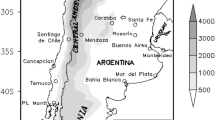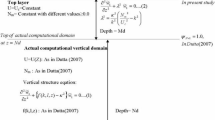Abstract
Barrier winds form when a sufficiently high mountain range causes a stratified airflow directed towards the orographic barrier to slow down at the low levels, producing a pressure imbalance, which in turn generates a mountain-parallel wind. The present study analyses barrier wind occurrence in the Italian region and surrounding seas from both a climatological and dynamical perspective. The main goals are to assess the applicability of the linear theory of upstream blocking to real-world cases and to investigate the role of atmospheric moist processes in promoting the formation and influencing the evolution of barrier winds. A 2-year climatology of barrier winds reveals that they occur more frequently than the opposite regime of flow over the orography, especially in the cold season. Barrier wind events are found to be associated with an upstream flow having a significantly higher inverse Froude number (or non-dimensional mountain height) values than flow-over events on average, consistently with the theory. An Alpine case study is simulated using numerical models and sensitivity tests are performed to investigate the dependence of barrier wind development and properties on the non-dimensional mountain height. Simulations reveal the strong influence of precipitation-related diabatic processes on the development of an upstream cold pool, which in turn supports barrier wind maintenance and strengthens its intensity. Idealized numerical experiments with varying upstream flow moisture shed light on processes leading to significant strengthening of barrier wind intensity, in particular on the crucial role of latent heat exchanges associated with precipitation.

















Similar content being viewed by others
References
Bertò A, Buzzi A, Zardi D (2004) Back-tracking water vapour contributing to precipitation events over Trentino: a case study. Meteorol Z 13:189–200
Bousquet O, Smull BF (2003) Observations and impacts of upstream blocking during a widespread orographic precipitation event. Quart J Roy Met Soc 129:391–409
Buzzi A, Tibaldi S (1978) Cyclogenesis in the lee of the Alps: a case study. Quart. J. Roy. Meteor. Soc. 104:271–287
Buzzi A, Cadelli R, Malguzzi P (1997) Low-level jet simulation over the Southern Ocean in Antarctica. Tellus 49 a:263–276
Buzzi A, Tartaglione N, Malguzzi P (1998) Numerical simulations of the 1994 Piedmont flood: role of orography and moist processes. Mon. Wea. Rev. 126:2369–2383
Buzzi A, Davolio S, Malguzzi P, Drofa O, Mastrangelo D (2014) Heavy rainfall episodes over Liguria in autumn 2011: numerical forecasting experiments. Nat Hazards Earth Syst Sci 14:1325–1340
Chen WD, Smith RB (1987) Blocking and deflection of airflow by the Alps. Mon. Wea. Rev. 115:2578–2597
Davolio S, Henin R, Stocchi P, Buzzi A (2017) Bora wind and heavy persistent precipitation: atmospheric water balance and role of air-sea fluxes over the Adriatic Sea. Quart. J. Roy. Meteor. Soc. 143:1165–1177
Di Muzio E (2013) Climatological characterization and dynamics of barrier winds in the Italian region. Master Thesis, University of Bologna. URI https://amslaurea.unibo.it/id/eprint/6688
Durran DR, Klemp JB (1982) On the effects of moisture on the Brunt-Väisälä frequency. J Atmos Sci 39:2152–2158
Fraser NJ, Inall ME (2018) Influence of barrier wind forcing on heat delivery toward the Greenland ice sheet. J Geophys Res Oceans 123:2513–2538
Harden BE, Renfrew IA, Petersen GN (2011) A climatology of wintertime barrier winds off Southeast Greenland. J Clim 24:4701–4717
Hines KM, Bromwich DH (2008) Development and testing of polar Weather Research and Forecasting (WRF) model. Part I: Greenland Ice Sheet Meteorology. Mon Wea Rev 136:1971–1989
Kain JS (2004) The Kain-Fritsch convective parameterization: an update. J Appl Meteorol 43:170–181
King JC, Turner J (2007) Antarctic meteorology and climatology. Cambridge University Press 424 pp
Lalas DP, Einaudi F (1974) On the correct use of the wet adiabatic lapse rate in stability criteria of a saturated atmosphere. J Appl Meteorol 13:318–324
Li J, Chen Y-L (1998) Barrier jets during TIMEX. Mon. Wea. Rev. 126:959–971
Loescher KA, Young GS, Winstead NS (2006) Climatology of barrier jets along the Alaskan coast. Part I: Spatial and temporal distributions. Mon Wea Rev 134:437–453
Lundquist JD, Minder JR, Neiman PJ, Sukovich E (2010) Relationships between barrier jet heights, orographic precipitation gradients, and streamflow in the northern Sierra Nevada. J Hydrometeorol 111:1141–1156
Malguzzi P, Grossi G, Buzzi A, Ranzi R, Buizza R (2006) The 1966 ‘century’ flood in Italy: a meteorological and hydrological revisitation. J Geophys Res 111:D24106
Malguzzi P, Buzzi A, Drofa O (2011) The meteorological global model GLOBO at the ISAC-CNR of Italy: assessment of 1.5 years of experimental use for medium range weather forecast. Wea. Forecasting 26:1045–1055
Markowski PM, Richardson Y (2010) Mesoscale meteorology in Midlatitude. Wiley-Blackwell
Marwitz JD (1987) Deep orographic storms over the Sierra Nevada. Part I: Thermodynamic and kinematic structure. J Atmos Sci 44:159–173
McCauley MP, Sturman AP (1999) A study of orographic blocking and barrier wind development upstream of the Southern Alps, New Zealand. Meteorol Atmos Phys 70:121–131
Miglietta MM, Buzzi A (2004) A numerical study of moist stratified flow regimes over isolated topography. Quart. J Roy Meteor Soc 130:1749–1770
Moore GWK, Renfrew IA (2005) Tip jets and barrier winds: a QuikSCAT climatology of high wind speed events around Greenland. J Clim 18:3713–3725
Morcrette J-J, Barker HW, Cole JNS, Iacono MJ, Pincus R (2008) Impact of a new radiation package, McRad, in the ECMWF Integrated Forecasting System. Mon Wea Rev 136:4773–4798
Neiman PJ, Sukovich EM, Ralph FM, Hughes M (2010) A seven-year wind profiler–based climatology of the windward barrier jet along California’s northern Sierra Nevada. Mon Wea Rev 138:1206–1233
Neiman, P. J., M. Hughes, B. J. Moore, F. M. Ralph and E. Sukovich, 2013: Sierra barrier jets, atmospheric rivers, and precipitation characteristics in northern California: a composite perspective based on a network of wind profilers. Mon Wea Rev, 141, 4211–4233
Nigro MA, Cassano JJ, Lazzara MA, Keller LM (2012) Case study of a barrier wind corner jet off the coast of the Prince Olav Mountains, Antarctica. Mon Wea Rev 140:2044–2063
O’Connor WP, Bromwich DH, Carrasco JF (1994) Cyclonically forced barrier winds along the Transantarctic Mountains near Ross Island. Mon Wea Rev 122:137–150
Orlanski I, Gross BD (1994) Orographic modification of cyclone development. J Atmos Sci 51:589–611
Parish TR (1982) Barrier winds along the Sierra Nevada mountains. J Appl Meteorol 21(7):925–930
Parish TR (1983) The influence of the Antarctic Peninsula on the wind field over the western Weddell Sea. J Geophys Res Oceans 88:2684–2692
Petersen GN, Renfrew IA, Moore GWK (2009) An overview of barrier winds off southeastern Greenland during the Greenland Flow Distortion experiment. Quart J Roy Meteor Soc 135:1950–1967
Pierrehumbert RT, Wyman B (1985) Upstream effects of mesoscale mountains. J Atmos Sci 42:977–1003
Reeves HD, Lin Y-L, Rotunno R (2008) Dynamic forcing and mesoscale variability of heavy precipitation events over the Sierra Nevada mountains. Mon Wea Rev 136:62–77
Rotunno R, Ferretti R (2001) Mechanisms of intense Alpine rainfall. J Atmos Sci 58:1732–1749
Rotunno R, Houze RA (2007) Lessons on orographic precipitation from the Mesoscale Alpine Programme. Quart. J. Roy. Meteor. Soc. 133:811–830
Rotunno R, Grubišić V, Smolarkiewicz PK (1999) Vorticity and potential vorticity in mountain wakes. J Atmos Sci 56:2796–2810
Schwerdtfeger W (1974) Mountain barrier effect on the flow of stable air north of the Brooks Range. Proceedings of the 24th Alaska Science Conference, University of Alaska, 204–208
Schwerdtfeger W (1979) Meteorological aspects of the drift of ice from the Weddell Sea toward the mid-latitude westerlies. J. Geophys. Res. Oceans 84:6321–6328
Schwerdtfeger W (1984) Weather and climate of the Antarctic. Elsevier Sciences Publisher, 261 pp
Seefeldt MW, Cassano JJ (2008) An analysis of low-level jets in the Greater Ross Ice Shelf region based on numerical simulations. Mon Wea Rev 136:4188–4205
Seefeldt MW, Cassano JJ, Parish TR (2007) Dominant regimes of the Ross Ice Shelf surface wind field during austral autumn 2005. J Appl Meteor Clim 46:1933–1955
Simpson GC (1919) Meteorology: British Antarctic expedition 1910–13. Thacker, Spink, Calcutta, 464 pp.
Smith RB (1980) Linear theory of stratified hydrostatic flow past an isolated mountain. Tellus 32:348–364
Smith RB (1988) Linear theory of hydrostatic flow over an isolated mountain in isosteric coordinates. J Atmos Sci 45:3889–3896
Smolarkiewicz PK, Rotunno R (1989) Low Froude number flow past three-dimensional obstacles. Part I: Baroclinically generated lee vortices. J Atmos Sci 46:1154–1164
Smolarkiewicz PK, Rotunno R (1990) Low Froude number flow past three-dimensional obstacles. Part II: Upwind flow reversal zone. J Atmos Sci 47:1498–1511
van den Broeke MR, Gallée H (1996) Observation and simulation of barrier winds at the western margin of the Greenland ice sheet. Quart J Roy Meteor Soc 122:1365–1383
Wilks DS (2011) Statistical methods in the atmospheric sciences. Third Edition. Amsterdam, Elsevier
Zampieri M, Malguzzi P, Buzzi A (2005) Sensitivity of quantitative precipitation forecasts to boundary layer parameterization: a flash flood case study in the Western Mediterranean. Nat Hazards Earth Syst Sci 5:603–612
Acknowledgments
We thank ARPAV (Agenzia Regionale per la Prevenzione e Protezione Ambientale del Veneto) for providing observational data for the Veneto region that was used for the Alpine case study.
Author information
Authors and Affiliations
Corresponding author
Rights and permissions
About this article
Cite this article
Buzzi, A., Di Muzio, E. & Malguzzi, P. Barrier winds in the Italian region and effects of moist processes. Bull. of Atmos. Sci.& Technol. 1, 59–90 (2020). https://doi.org/10.1007/s42865-020-00005-6
Received:
Accepted:
Published:
Issue Date:
DOI: https://doi.org/10.1007/s42865-020-00005-6




